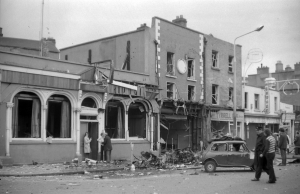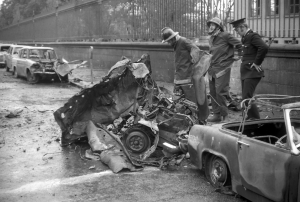‘The forgotten massacre’: responses to the Dublin and Monaghan bombings
Published in Features, Issue 3 (May/June 2014), Troubles, Volume 22
The Welcome Inn on Parnell Street, where the first Dublin bomb exploded at c. 5.28pm, killing ten people. (Dublin City Public Libraries)
At around 5.30pm on Friday 17 May 1974, three car bombs exploded in the centre of Dublin. Just before 7pm another explosion took place outside a pub in Monaghan town. Thirty-three people died as a result of what was the worst single atrocity in the history of the Northern Ireland conflict.
The bombings came as the North was paralysed by the loyalist Ulster Workers Council strike, aimed at bringing down the power-sharing Sunningdale agreement. As they struggled to come to terms with what the Irish Independent called ‘the blackest day in Ireland this century’, many assumed that the ‘Troubles’ had finally come south. Hibernia magazine reflected that it was ‘a sad but true fact’ that it was not until after the bombings that southerners came ‘near to appreciating the full extent of the suffering, terror and bloodshed which has been an integral part of everyday life for both communities in Northern Ireland for the past four years’. The Irish Press predicted that if loyalists were found to be responsible ‘the results could very likely be utterly counter-productive and throw support on the side of those who would use the bombers’ tactics to overthrow the Loyalist cause’. But in fact the opposite seems to have occurred. The bombs of May 1974 produced resignation, not anger. Indeed, much of what anger there was tended to be aimed at republican paramilitaries.
Press reaction
The tone was set by Taoiseach Liam Cosgrave, leader of the Fine Gael/Labour coalition, when he asserted that ‘everyone who has practised or preached violence or condoned violence must bear a share of responsibility for today’s outrages’. Fianna Fáil’s Jack Lynch agreed, stressing that ‘every organisation involved in a campaign of bombing in any part of our country over the past four years has the blood of these innocent victims on their hands’. The attorney-general, Declan Costello, argued that a ‘very heavy burden of responsibility’ for the deaths lay with the IRA. Mayo’s Western People claimed that it was ‘IRA outrages in the North and in London which led to this retaliatory massacre in Dublin and Monaghan’. Journalist Con Houlihan asked republican supporters to ponder whether it was ‘more acceptable that people be blasted to death in (Belfast’s) Donegall Street than in (Dublin’s) Lincoln Place?’ In his view, the ‘architects of Belfast’s Bloody Friday belong to the same moral order as those who committed last week’s blasphemy in Monaghan and Dublin’. John Healy (the Irish Times’ ‘Backbencher’) reflected that ‘death in Dublin isn’t any worse or more brutal than the deaths of over 1,000 people in Belfast or the other Irish towns and villages in the North’, and asked why it seemed that some ‘weep more . . . because it happens to “Irish” Irish people?’ He then suggested that there had been ‘a smug view that the Orange militants couldn’t mount a Provo-type campaign in the South’, but now ‘we’d soon see how many indulgent supporters there’d be for the Provos if the sons and daughters of Mayo or Kerry or Sligo parents were at risk in Dublin city’. Republican condemnations of the bombs were dismissed as hypocritical. Frank Ward of the Sunday Press argued that it was ‘hard not to feel sick at the expressions of sympathy from violent organisations who tomorrow are likely to kill more innocent bystanders’. The general view seemed to be that if the IRA had not been active, Dublin and Monaghan would not have been targeted.
Lack of popular anger
Observers noted the lack of popular anger. Gillian Linscott of The Guardian wrote that while it was accepted that ‘the bombings were the work of Loyalists . . . there is no sign of sectarian bitterness at government level and privately among the people of Dublin. Government ministers and opposition politicians have gone out of their way to point out that regardless of who placed the car bombs much of the moral responsibility must rest with the Provisional IRA.’ She found that ‘for most people’ the deaths were seen as ‘personal and family tragedies (not) political martyrdom’. The government’s decision not to hold a national day of mourning also meant that much of the grieving was done in private. British ambassador Arthur Galsworthy also informed London that there had been no ‘anti-Northern Protestant reaction’ and that instead ‘it was the Provisionals . . . who were attracting most of the opprobrium on account of their own long-standing association with violence’. In his view this was both a ‘helpful’ and ‘healthy’ development. A month after the bombings, leading Northern Ireland civil servant Maurice Hayes found that ‘the general public attitude in Dublin to the Northern Ireland situation ranges from apathy to ambivalence. Most people are fed up with the Northern Ireland issue and wish it would go away—preferably not in their direction. The Dublin car bombs had a profound effect and people are very afraid of the spread of violence to the South.’ Indeed, some reacted by blaming all northerners. One Dubliner, writing to the taoiseach to demand tighter security the day after the bombings, asserted that ‘the people from the six counties are a very argumentative race . . . If you had a referendum in the Republic in the morning or at any time in the past few years to see if we wanted [them] as part of our country it would be a hundred to one against.’
Dissenting voices
There were some dissenters. Hugh Munro of the Irish Press wondered why ‘responsibility for the deaths lay with all sorts of people but no responsibility at all is specifically imputed to those who actually planted the bombs’. Fianna Fáil TD Vivion de Valera pointed out that ‘it was not the IRA who bombed Dublin’. With the very recent ex-perience of the Dublin bombings of December 1972, some argued that a similar process was at work. Monaghan’s Northern Standard suggested that British intelligence may have calculated that ‘a few bombs south of the Border’ would force the Irish state into ‘all-out war against the IRA, on whom the blame could be pinned for this “Protestant reprisal”’.

The wreckage of the third Dublin bomb (c. 5.32pm) at South Leinster Street (with Trinity College railings in the background), where two women were killed instantly. Seven more people would be killed when a fourth bomb exploded outside Greacan’s pub in Monaghan town at c. 6.58pm. (Dublin City Public Libraries)
Therefore Monaghan people ‘should be hesitant about blaming loyalists for bombing the town’. Provisional Sinn Féin accused the British Special Air Service (SAS) of carrying out the bombings but argued that the ‘Dublin government must bear full responsibility’ because it had ignored the threat from British agents on its territory. Republican analysis of the reasons behind the bombs was contradictory, however. During early 1974 both the Official and Provisional IRA had been engaged in talks with the loyalist UVF. Sinn Féin’s An Phoblacht had argued that ‘Republicans should be grateful to the Loyalists for the initial results of the [UWC] strike, brought about by a minimum of physical force and suffering, and largely devoid of sectarian brutality’. It asserted that ‘the strike was in the Wolfe Tone tradition in so far as it was breaking the connection with England’. As a result, some republicans suggested that the British had bombed Dublin in order to weaken the loyalist strike; ‘the Sunningdale Agreement now being in danger, the SAS had to strike to save it’. Even for those who presumed that British agents were involved this analysis must have seemed unlikely.
While two years previously Bloody Sunday had provoked rage and the burning of the British embassy, slaughter on the streets of Dublin and Monaghan seems to have instilled only despair. Forty years on this seems difficult to understand, as does the rush to accuse republicans for being as much to blame as the actual bombers. But disillusion with the violence had been growing since 1972 and much of that disillusion had focused on the IRA. As Denis Barror, who was injured in the bombings, remembered, ‘there was almost a feeling that the Republic had paid its due for the havoc released by the IRA in the North of Ireland, and that the politicians, in common with an awful lot of people in this country, almost felt personally responsible for the depredations of the organisation that carried out bombings in the North in the name of the Irish Republican Army’. By the time the bombings occurred many had already distanced themselves from the conflict north of the border, and the slaughter in Dublin simply accelerated this process.
Barron reports
The commission of inquiry into the bombings headed by Justice Henry Barron, published in 2003, argued that the attacks were carried out by UVF members from Belfast and mid-Ulster. Much of the preparation took place at a farm at Glennane, Co. Armagh, owned by RUC Reservist James Mitchell, which was the centre of operations for a UVF gang who killed up to 120 people. Members of the Ulster Defence Regiment and the RUC were likely to have participated in the bombings. It stated that while it was ‘neither fanciful nor absurd’ to suspect British involvement, the UVF was capable of carrying out the bombings on its own. The inquiry received only limited cooperation from the British government, however, and was not able to access what evidence might exist in British state archives.
The Barron reports (on-line link below) contain a vast amount of information on attacks in the republic between 1970 and 1976. The failure to point the finger definitively at British involvement disappointed many campaigners. But one of the report’s most devastating assertions was that the 1973–7 government ‘showed little interest’ in pursuing those responsible for the bombs. When information was given to the cabinet suggesting that the British had intelligence naming the bombers, ‘it was not followed up’. Aside from the identity of those who planned the bombings, the outstanding question must be why an Irish government did so little to find and prosecute those who carried out a mass murder of its citizens.
Brian Hanley is a historian and author.
Read More: Who bombed Dublin and Monaghan?
‘The forgotten massacre’
Further reading
A. Cadwallader, Lethal allies: British collusion in Ireland (Cork, 2013).
Houses of the Oireachtas, Reports of the Independent Commission of Inquiry into the Dublin and Monaghan Bombings (Dublin, 2003–6), http://www.dublinmonaghanbombings.org/DubMonInterim.pdf.
D. Mullan, The Dublin and Monaghan bombings: the truth, the questions and the victims’ stories (Dublin, 2000).
E. Sweeney, Down, down, deeper and down: Ireland in the 70s and 80s (Dublin, 2010).
















